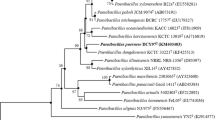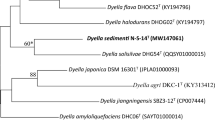Abstract
A Gram-negative, aerobic, oval-shaped, and light red pigmented bacterium, designated T6-1T, was isolated from the mash of wine collected from a wine-making laboratory simulated fermenter located in Beijing, China. The optimal growth of T6-1T occurred at 30 °C, pH 7.0 with 1% NaCl. The sole respiratory quinone was menaquinone-7 (MK-7). The principal cellular fatty acids (>5%) were iso-C15:0, iso-C17:0 3OH, C16:1 ω5c, and iso-C17:0. The major polar lipids were PE (phosphatidylethanolamine), PL (unidentified phospholipid), and L1-2 (unidentified lipids). 16S rRNA phylogenetic analysis indicated that strain T6-1T belonged to the genus Pontibacter. The 16S rRNA gene sequence of strain T6-1T was most similar to Pontibacter amylolyticus 9-2T (95.92%). The genomic DNA G+C content of strain T6-1 was 50.34 mol%. The digital DNA–DNA relatedness and average nucleotide identity value between T6-1T and 9-2T was 20.20% and 74.18%, respectively. Polyphasic taxonomy analysis indicated that strain T6-1T represents a novel species of the genus Pontibacter, for which the name Pontibacter beigongshangensis sp. nov. is proposed, with the type strain T6-1T (= CGMCC 1.17104T = KCTC 72413T).

Similar content being viewed by others
References
Auch AF, Klenk H, Goeker M (2010) Standard operating procedure for calculating genome-to-genome distances based on high-scoring segment pairs. Stand Genomic Sci 2(1):142–148. https://doi.org/10.4056/sigs.541628
Felsenstein J (1981) Evolutionary trees from DNA sequences: a maximum likelihood approach. J Mol Evol 17(6):368–376. https://doi.org/10.1007/BF01734359
Fitch WM (1971) Toward defining the course of evolution: minimum change for a specific tree topology. Syst Zool 20(4):406–416
Fluharty DM (1967) The KOH method for detecting the gram-staining potential of bacteria without staining. In: Proceedings, annual meeting of the United States Animal Health Association, vol 71, pp 473–479
Gonzalez C, Gutierrez C, Ramirez C (1978) Halobacterium vallismortis sp. nov. An amylolytic and carbohydrate-metabolizing, extremely halophilic bacterium. Can J Microbiol 24(6):710–715. https://doi.org/10.1139/m78-119
Hu HY, Lim BR, Goto N, Fujie K (2001) Analytical precision and repeatability of respiratory quinones for quantitative study of microbial community structure in environmental samples. J Microbiol Methods 47(1):17–24. https://doi.org/10.1016/S0167-7012(01)00286-X
Joung Y, Kim H, Ahn T, Joh K (2011) Pontibacter salisaro sp nov., Isolated from a clay tablet solar saltern in Korea. J Microbiol 49(2):290–293. https://doi.org/10.1007/s12275-011-0093-6
Kimura M (1980) A simple method for estimating evolutionary rates of base substitutions through comparative studies of nucleotide sequences. J Mol Evol 16(2):111–120. https://doi.org/10.1007/BF01731581
Kodaka H, Armfield AY, Lombard GL, Dowell VRJ (1982) Practical procedure for demonstrating bacterial flagella. J Clin Microbiol 16(5):948–952
Li R, Li Y, Kristiansen K, Wang J (2008) SOAP: short oligonucleotide alignment program. Bioinformatics 24(5):713–714. https://doi.org/10.1093/bioinformatics/btn025
Li R, Zhu H, Ruan J, Qian W, Fang X, Shi Z, Li Y, Li S, Shan G, Kristiansen K, Li S, Yang H, Wang J, Wang J (2010) De novo assembly of human genomes with massively parallel short read sequencing. Genome Res 20(2):265–272. https://doi.org/10.1101/gr.097261.109
Meier-Kolthoff JP, Auch AF, Klenk H, Goeker M (2013) Genome sequence-based species delimitation with confidence intervals and improved distance functions. BMC Bioinform 14(60):1. https://doi.org/10.1186/1471-2105-14-60
Nedashkovskaya OI, Kim SB, Suzuki M, Shevchenko LS, Lee MS, Lee KH, Park MS, Frolova GM, Oh HW, Bae KS, Park HY, Mikhailov VV (2005) Pontibacter actiniarum gen. nov., sp nov., a novel member of the phylum ‘Bacteroidetes’, and proposal of Reichenbachiella gen. nov as a replacement for the illegitimate prokaryotic generic name Reichenbachia Nedashkovskaya et al. 2003. Int J Syst Evolut Microbiol 55(6):2583–2588. https://doi.org/10.1099/ijs.0.63819-0
Ren Q, Hou C (2017) Isolation and identification of microorganisms in Wheat Qu of Beizong Rice Wine. Food Sci 38(04):77–82. https://doi.org/10.7506/spkx1002-6630-201704013
Saitou N, Nei M (1987) The neighbor-joining method: a new method for reconstructing phylogenetic trees. Mol Biol Evol 4(4):406–425
Sasser M (1990) Identification of bacteria by gas chromatography of cellular fatty acids. Vol. MIDI Technical Note 101. MIDI Inc., Newark, DE, USA
Tamura K, Stecher G, Peterson D, Filipski A, Kumar S (2013) MEGA6: molecular evolutionary genetics analysis version 6.0. Mol Biol Evol 30(12):2725–2729. https://doi.org/10.1093/molbev/mst197
Thompson JD, Gibson TJ, Plewniak F, Jeanmougin F, Higgins DG (1997) The CLUSTAL_X windows interface: flexible strategies for multiple sequence alignment aided by quality analysis tools. Nucleic Acids Res 25(24):4876–4882. https://doi.org/10.1093/nar/25.24.4876
Wu Y, Zhou P, Jian S, Liu Z, Wang C, Oren A, Xu X (2016) Pontibacter amylolyticus sp. nov., isolated from a deep-sea sediment hydrothermal vent field. Int J Syst Evolut Microbiol 66(4):1760–1767. https://doi.org/10.1099/ijsem.0.000944
Xu P, Li WJ, Tang SK, Zhang YQ, Chen GZ, Chen HH, Xu LH, Jiang CL (2005) Naxibacter alkalitolerans gen. nov., sp nov., a novel member of the family ‘Oxalobacteraceae’ isolated from China. Int J Syst Evolut Microbiol 55(3):1149–1153. https://doi.org/10.1099/ijs.0.63407-0
Yoon S, Ha S, Kwon S, Lim J, Kim Y, Seo H, Chun J (2017) Introducing EzBioCloud: a taxonomically united database of 16S rRNA gene sequences and whole-genome assemblies. Int J Syst Evolut Microbiol 67(5):1613–1617. https://doi.org/10.1099/ijsem.0.001755
Funding
This study was supported by Youth Funding of Beijing Technology and Business University (PXM2019_014213_000007), the Beijing Technology and Business University Graduate Research Capacity Improvement Program in 2019, the National Key Research and Development Program of China (2018YFC1603606). We would like to thank China General Microbiological Culture Collection Center (CGMCC) for their help with the predominant quinone, fatty acids, polar lipids, and Biolog GENIII analysis, Professor Yingmin Jia with preparing Biolog GEN III MicroStation System.
Author information
Authors and Affiliations
Contributions
Q.R. and J.L.X.: Methodology; L.P.S.: Writing and Original Draft Preparation; Z.B.S.: Review & Editing; X.X: Species identification; J.L.: Strain isolation; X. L.: Supervision; Y.H.: Transmission electron microscope. All authors have read and approved the manuscript.
Corresponding author
Ethics declarations
Conflict of interest
The authors have no financial conflicts of interest to declare.
Additional information
Publisher's Note
Springer Nature remains neutral with regard to jurisdictional claims in published maps and institutional affiliations.
Nucleotide Sequence Accession Number
The 16S rRNA gene sequence of strain T6-1T was submitted in GenBank to get accession number MK860107.1. The whole genome shotgun sequencing project of strain T6-1T has been deposited in GenBank to get accession number VFSD00000000. The type strain is T6-1T (= CGMCC 1.17104T = KCTC 72413T).
Electronic supplementary material
Below is the link to the electronic supplementary material.
Rights and permissions
About this article
Cite this article
Xu, J., Sun, L., Sun, Z. et al. Pontibacter beigongshangensis sp. nov., Isolated from the Mash of Wine. Curr Microbiol 76, 1525–1530 (2019). https://doi.org/10.1007/s00284-019-01782-w
Received:
Accepted:
Published:
Issue Date:
DOI: https://doi.org/10.1007/s00284-019-01782-w




